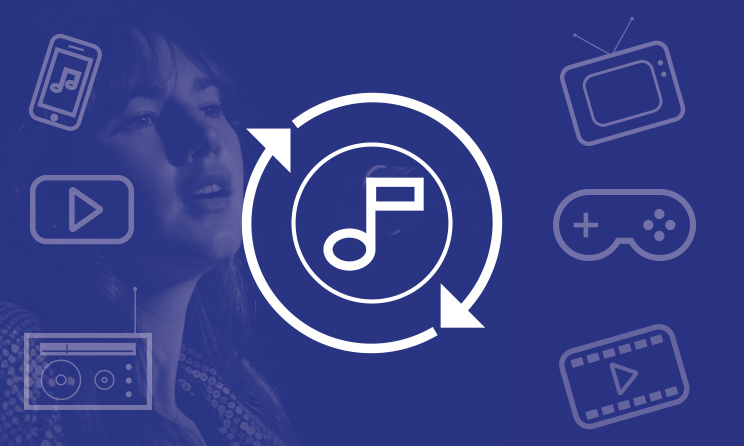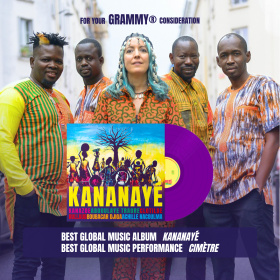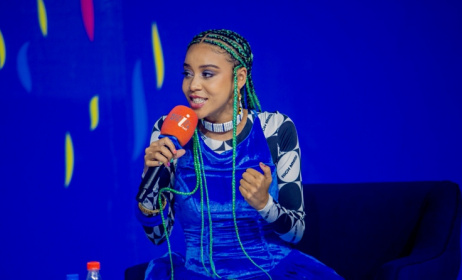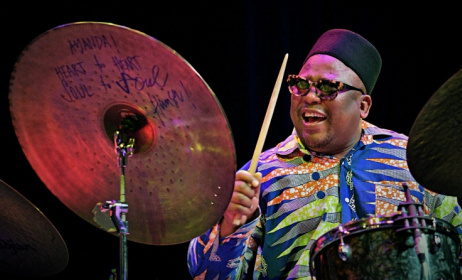Understanding sync licences in South Africa
For film and production houses to reproduce music in video formats – such as films, TV shows, video games, adverts and even YouTube content – they need to negotiate for permission from the rightsholders of the song, and they are usually required to pay a fee for its use.
These fees, known as synchronisation licences, are an important revenue stream for South African musicians and copyright owners. For short, we often call these licences ‘sync licences’ and – according to Music In Africa’s Revenue Streams for Music Creators in South Africa 2022 report – they generate an average monthly income of R14 453.
What are sync licences?
The permission to reproduce music in timed relationship in a video is referred to as a sync licence. Technically, the sync licence refers to clearing the composition half of a song (i.e. the melody and lyrics) for licensing. The sound recording requires a master use licence, but, in general, both licences are grouped together as sync licences.[1]
To obtain this permission, production houses pay a sync licence fee, which then goes to the rightsholders – like musicians, writers, performers or copyright owners – in the form of sync royalties. In South Africa, the Composers, Authors and Publishers Association (CAPASSO) facilitates blanket licences to broadcasters and pays musicians from sync fees received. However, sync fees are often privately negotiated by rightsholders, typically music publishers or record labels if not principal artists or songwriters.[2]
Furthermore, as the synchronised video is broadcast to the public, public performance royalties are also generated from these videos, known as residuals. Publishers often consider sync as a primary source of revenue, and the resulting additional royalties as residual to that. The Southern African Music Rights Organisation (SAMRO) also provides similar blanket licences to broadcasters, and pays musicians public performance royalties generated from the synchronised video.[3]
Finally, bear in mind that some synchronisations require custom music. If music is tailored for specific video footage, publishers and musicians can request an upfront commission fee in addition to the royalties from CAPASSO and SAMRO. Think of a film composer writing music to go with scenes of a movie. The film company may have a perpetual sync agreement with the composer for a fixed fee, but the composer may then ask for residual royalties from other uses of the music, such as the original music soundtrack to the film.
Are sync royalties worth it?
Sync royalties have great potential to boost revenue, as sync licence fees and synchronisation unit rates are generally far higher than those associated with radio broadcasts.
According to SAMRO’s July 2021 unit rates, 7/10 of the top-paying unit rates are derived from TV synchronisations. Depending on where a song is placed – and whether it’s cleared for use in South Africa or the whole world – 30 seconds on a TV advert can generate up to R38 000. And, if the same advert is played 500 times, this could make an additional R27 000 in performance royalties.[4]
When you factor in multiple video formats, different cuts of the advert, different countries, exchange rates, and levels of exclusivity (all typical features of global ad campaigns), revenue derived from sync placements can climb into the millions of rand.
How to find sync deals for your music
There are three main pathways towards finding sync deals for your music in South Africa:
- Place your music in music libraries. A good music library typically has established relationships with several production houses, advertisers and relevant stakeholders, such as CAPASSO. This method is ideal for musicians who don’t want the hassle of building a network and just want to focus on creating music: once new tracks are done, the library will direct traffic to your music. A drawback to this approach, however, is that there are music libraries that don’t get quality placements or quality traffic. Be vigilant in researching the music library and its traffic data. If you’re uncertain about the library, try to sign a non-exclusive deal. Or, if it only offers exclusive deals, try to negotiate for a limited term (length) of deal, where possible.
- Find a publisher. Publishers will typically handle all the administration work associated with registering your music with an appropriate library, while also maintaining strong relationships with music users. Like engaging directly with music libraries, this method is ideal for musicians who don’t want the hassle of building a network and just want to focus on creating new music. The publisher will leverage their connections to get quality music placed, but will typically take more of the royalties earned than music libraries (up to 50% of artist earnings).
- Build the network yourself. Building a network requires great interpersonal skills, a lot of work, a lot of time, and persistence. Musicians who have a great work ethic can build their own networks for sync placements, and will be rewarded for this approach by keeping all the royalties they are able to generate for themselves. However, they will lose out on time to make music. This approach may be favourable for musicians with friends or associates who are active in the advertising and film production industries.
Video: SyncFloor is a platform that helps production companies to find music using natural search terms.
Recommended steps to follow
Here are some recommended steps for musicians to take in order to get their music considered for film and TV synchronisation:[5]
- Decide on your approach. Musicians should first decide if they want to work with a music library, publisher or build their own network. Musicians who are new to sync should ideally work with niche music libraries to learn the basic deliverables and build a résumé of placements.
- Focus your output. Musicians who work within multiple genres should focus on a specific genre and preferably theme/mood per album.
- Make your music searchable. Ensure your metadata includes keywords suited to music libraries, such as mood, style, tempo, possible sync type (documentary, animation, etc), as well as ‘sounds-like' suggestions.
- Conduct market research. Most music libraries have their catalogues available on their websites. Some also advertise recent placements on their websites. Musicians can listen and see what genres are placed. If the library has multiple volumes of a specific type of genre, then it most probably means they have a high demand for this genre. Ideally, you should aim to approach libraries with a high demand for the genre but a low supply. Finally, proceed with caution if publishers/libraries don’t have a website, or if their website seems outdated.
- Produce coherent 10-12 track albums. Music libraries and publishers typically release music albums with 10-12 tracks suited to music libraries. These are typically not commercial music albums with a principle artist, but music that fits moods and themes. Musicians who can make high-quality albums in the same genre and with the same mood/emotion will find publishers and music libraries that will be more eager to work with them.
- Mix and master your music. High-quality mixing and mastering of your music is crucial.
- Select the best song to pitch. Select two or three of the best tracks from the album in your initial pitch.
- Upload your best songs. Your best songs should be uploaded to your website or a private SoundCloud streaming link.
- Pitch to music libraries. Email the music library or publisher. Have a strong subject heading – for example, “12 Track Uplifting Future Bass Album for Exclusive Placement”). Your initial pitch should be short and straight to the point. If the music library has a highlight reel of previous placements, compliment them on what you’ve seen. Provide a streaming link to your music (do not attach MP3s). If the library has submission guidelines in place, be sure to follow these precisely. Always be professional in your correspondence – and do not submit the same album to multiple libraries at the same time, because they might insist on exclusive use.
- Follow up. Music libraries and publishers are constantly busy building and maintaining relationships across multiple industries. Therefore, musicians should follow up on their submission after four to 6 weeks have passed. If you still have not received a response for another four weeks after that, then it’s safe to assume the submission was not successful – and you can submit the album to another library.
Further thoughts
For artists who are new to the world of sync licensing, it is important to remember that sync music is different to artist tracks. Study how catalogue music is structured, how it evolves and the typical instrumentation it employs. If possible, find some pieces of library music that you like, and use them as reference tracks as you develop your skills.[6]
If you are unsure of where to start, you can find music publishers and music libraries on the CAPASSO rate card the CAPASSO publishers members section and the SAMRO online portal. Use the SAMRO portal to find out if the music publisher or library has been getting royalties. Discover which albums have received placements, and study three to five tracks from the album to get a feel of what the production houses are looking for.
Finally, bear in mind that sync royalties take some time to go through the system until they reach musicians. Unless the sync is negotiated directly, patience is important for this royalty stream, as it is normal to wait 12 to 24 months (or longer) for sync royalties to be processed, as you may need to wait until certain payment thresholds are reached by libraries or wait for distribution periods of CMOs.
Resources and citations
- [1] Songtradr. (2021). “What is sync licensing?”. Accessed on January 11, 2022: https://blog.songtradr.com/what-is-sync-licensing/
- [2] CAPASSO. (2021). Production Music Rate Card 2021. Accessed on January 11, 2022: https://www.capasso.co.za/wp-content/uploads/2021/07/3e5d55_1e30bc642ba94354a4143fd5fd44b4be.pdf
- [3] SAMRO. (2021). SAMRO Performing Rights Royalty Distribution Rules. Accessed on January 11, 2022: https://www.samro.org.za/sites/default/files/SAMRO%20Performing%20Rights%20Royalty%20Distribution%20Rules.pdf
- [4] SAMRO. (2020). “Music User”. Accessed on January 11, 2022: https://www.samro.org.za/music-user
- [5] Ditto Music. (2018). “How To Submit Music For TV & Film”. Accessed on January 11, 2022: https://dittomusic.com/en/blog/how-to-submit-music-for-tv-and-film/
- [6] Ibid.
This article is part of the Revenue Streams for African Musicians project, supported by UNESCO’s International Fund for Cultural Diversity in the framework of the UNESCO 2005 Convention on the Protection and Promotion of the Diversity of Cultural Expressions, the Siemens Cents4Sense programme, Siemens Stiftung, Goethe-Institut, the National Arts Council of South Africa and Kaya FM.
Editing by David Cornwell and Kalin Pashaliev

























Commentaires
s'identifier or register to post comments